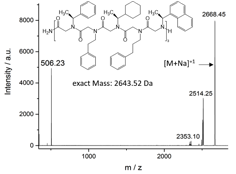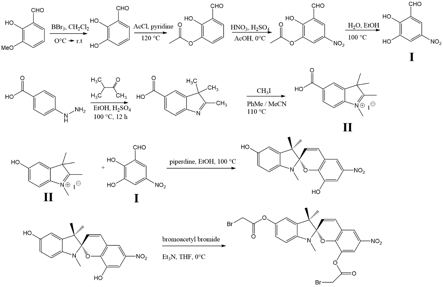Reports: ND755008-ND7: Sequence Controlled Polymers Using Solid Supported Chemistry
Christopher K. Ober, PhD, Cornell University
Sequence defined polymers were synthesized by solid supported peptoid chemistry following Zuckermann's submonomer synthesis. This reaction (Scheme 1) does not require any protecting group and allows an automated synthesis resulting in a good sequence control due to a simple and efficient purification by washing. New customized synthesis protocols and the use of water jacketed reaction vessels enabled us to perform all experiments with our peptide synthesizer.
Scheme 1 Reaction scheme of Zuckmermann's submonomer synthesis to form peptoids.
The structure of peptoid polymers can be controlled by choosing suitable side chains. An interesting polymer structure to start with is a helix, since study of the impact of sequence variation on the helical pitch as well as the response to mechanical stress via the extension of the helix is possible. A chemically linked mechanochromic dye will then visualize the mechanical response under stress (Figure 1).
Figure 1 Color change of the mechanochromic peptoid helices.
Our first goal was to synthesize extended peptoids with an aromatic unit in the backbone (Figure 2). These peptoids have a higher chain stiffness and a more uniform structure compared to normal peptoids (N-substituted glycines).
Figure 2 Chemical structure of extended peptoids and N-substituted glycine peptoids.
After several unsuccessful trials the use of the reactive Rink amide resin, long reaction times (150 minutes), high excess of reactants (12 equiv. bromoacetic acid and 15 eqiv. amines) and high reaction temperatures (35 °C) in each reaction step resulted in an increase of the crude product yield (from 20 % to 80 %) and in a high purity grade (amount of main fraction increased from 37 to 82 %). However, MS data indicated that one of the amine substituents popped off either during synthesis or during the cleavage process with TFA. Replacement of (S)-(-)-a-4-dimethylbenzylamine by the more acid stable (S)-(+)-1-cyclohexylethylamine successfully resulted in the first 5 letter peptoid sequence with an acceptable purity grade of 70 % (Figure 3).
Figure 3 Mass spectrum (ESI-MS) of a peptoid with 5 letter sequence.
Preliminary experiments to synthesize a chiral peptoid oligomer with three repeats of a 5 letter sequence were performed in collaboration with the Segalman group at UC Santa Barbara. The overall purity dramatically increases if the acylation step is performed twice, probably due to steric hindrance of the a-chiral amines and the aromatic substituents. However, a further modification of the sequence was necessary since the (4-methoxyphenyl)ethyl side chains in the middle of the backbone popped off during cleavage even if very low amounts of TFA (5%) were used. Reducing the sequence to 4 letters resulted in the first successful synthesis of a chiral peptoid oligomer (Figure 4 a).
a) |
b) |
Figure 4 a) MALDI-TOF spectrum of a peptoid oligomer with 4 different letters. b) CD Spectrum of the same peptoid oligomer at different concentrations in acetonitrile.
Adding (S)-(-)-1-(1-naphthyl)ethylamine to the sequence resulted in successful synthesis of a chiral 5 letter peptoid oligomer having an alternating chiral/nonchiral sequence (Figure 5 a). A second peptoid oligomer with the same monomers but with a chiral-block-nonchiral sequence was also successfully synthesized. This sequence variation might impact the helical pitch and should allow to analyze the influence of the sequence order on the mechanical properties of the peptoid oligomer.
a) |
b) |
Figure 5 a) MALDI-TOF spectrum of the alternate chiral/nonchiral peptoid oligomer. The spectrum of the chiral-block-nonchiral peptoid oligomer looks similar. b) CD Spectrum of both 5 letter peptoid oligomers in acetonitrile (c = 0.5 mM). The a-helix was also observed for the alternate chiral/nonchiral peptoid oligomer at a higher concentration (1 mM) (not shown here).
The analysis of all peptoid oligomers via CD spectroscopy indicated a right handed a-helix formation at very low concentrations in acetonitrile (Figure 4 b and 5 b). However, with increasing concentration a bathochromic shift in conjunction with a shape change of the absorbance band was detected (Figure 4 b). This is rather more known for peptides than for peptoids and indicates intermolecular interactions like multimer formation. Together with the Zuckermann group at the University of California, Berkeley, who have done some research in this field, but never observed multimer formation with CD spectroscopy, we want to investigate this interesting phenomenon further.
In addition Figure 5 b indicates that the formation of the a-helix is dependent from the sequence order. The chiral-block-nonchiral peptoid oligomer showed a more distinct a-helix signal, i.e. the a-helix signal is detectable at lower concentrations. This probably indicates a slightly different structure (different pitch) and may result in different mechanical properties. Further studies will follow.
Beside these promising results we almost finished the multiple-step synthesis of the mechanochromic dye (Scheme 2). Only the final product, the bromine functionalized spiropyran, needs to be completely purified before it can be used as a chemical linker between two peptoid oligomers to visualize the mechanical response under stress. Preliminary experiments showed a successful functionalization of the peptoid oligomers with thiol or triple bond end groups, which enables click chemistry as an alternative for the linkage, if the coupling efficiency via nucleophilic substitution is too low.
Scheme 2 Synthesis scheme of the bromine functionalized spiropyran.
In summary helical peptoid oligomers with 4 and 5 letter sequences were successfully synthesized. End group functionalization of these materials with thiol or triple bonds was possible. CD spectra indicate that the formation of the a-helix is dependent on sequence order. The use of 5 different amines in the peptoid synthesis will offer to generate 120 different combinations and may enable a precise control of the helical pitch.




















